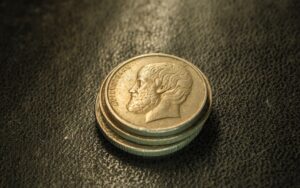In the vast tapestry of human civilization, few threads are as integral to the fabric of society as money. From bartering to digital currencies, the evolution of money mirrors the progress of human ingenuity and the complexities of economic systems. In this article, we will unravel the intricate history of money, tracing its origins, pivotal moments, and the fascinating transformations that have shaped the financial landscapes of different eras.
The Genesis of Exchange

1. The Barter System
The journey begins with the earliest form of exchange – the barter system’s challenges of a system reliant on the coincidence of wants. I want what you have, but you don’t want what I have to offer in exchange. This complexity forged the need for a standard medium of exchange.
2. Shells, Beads, and Commodity Money
The first transition was from barter to a commodity money, where items like shells and beads became widely accepted mediums of exchange, paving the way for more sophisticated monetary systems.
The Age of Metals

1. The Emergence of Metal Coins
Metal coins have always had a historical significance, from their introduction in ancient civilizations to their role in standardizing currency and facilitating trade on a broader scale. This was the beginning of standardization.
2. The Golden Era: Gold and Silver Standards
Gold and silver, for their unique qualities, became the standard metal of choice, influencing economies and trade routes across the globe.
Paper Money and Banking

1. The Birth of Paper Currency
The origins of paper money can be traced back to ancient China, which evolved into a more widely adopted form of currency, replacing heavy metal coins that became too cumbersome to carry around daily.
2. Banking Renaissance
This led to the emergence of early banking systems, from the Medici family in Italy to the first central banks; banks would “hold and protect” your gold and silver in their vault and issue you paper currency in exchange. The paper currency became an IOU for the gold and silver stored in the vault. This led to many bank runs, and failed banks as banks would create more IOUs then had gold and silver to back it up.
The Rise of Fiat Currency

1. The Abandonment of Gold
As countries wanted to spend above their means without restricting the gold standard, we see the abandonment of the gold standard during the 20th century and the rise of fiat currency, allowing governments to print as much money out of thin air as they desired. This consistent increase in the currency supply has led to a consistent increase in the cost of living.
2. Modern Banking and Credit
Modern banking is based on what is known as a fractional reserve system. This means banks can lend out up to 10 times as much currency as they have on deposit.
Digital Revolution

1. CBDC’s
Central Banks, determined to stay at the forefront of the digital revolution, have been developing CBDCs (central bank digital currencies). This digital money will lead to a cashless society where physical, tangible money is no longer legal tender. Leading to what some say will be a more authoritative government. As they know, the government can track and trace every transaction, causing an ever-increasing control of society… They don’t like what you say, buy, or do. They can deduct money directly from your digital wallet or, worse, ban you from having a wallet altogether. Those who oppose this conspiracy view say that this digital money will allow for a cheaper, faster global exchange than the current system in place and that this is just a natural evolution of money.
Conclusion
In this journey through the annals of financial history, we’ve witnessed the evolution of money from primitive barter systems to the intricate world of digital currencies. The history of money is not merely a chronicle of economic systems but a testament to human innovation, adaptability, and the relentless pursuit of more efficient means of exchange. As we stand on the cusp of unprecedented technological advancements, the future of money promises to be as dynamic and transformative as its storied past.
FAQ: Frequently Asked Questions
Q1: What is the oldest form of money?
A1: The oldest form of money is generally considered the barter system, where goods and services are exchanged directly.
Q2: When were metal coins first used?
A2: Metal coins first appeared in the 7th century BCE, likely in the Kingdom of Lydia in present-day Turkey.
Q3: Why did countries abandon the gold standard?
A3: Countries abandoned the gold standard to have more flexibility in managing their monetary policies, especially during economic downturns.
Q4: What is the role of blockchain in money?
A4: Blockchain technology has been crucial in developing digital currencies, offering secure and transparent transactions.
If you’d like to learn more about purchasing gold, silver, or platinum for physical delivery, in a storage and trading account, or within your IRA….
Book a Free, No-Obligation Precious Metals Consultation
and one of our Dedicated Account Representatives will educate you and answer your questions in detail.








